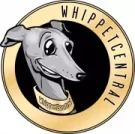Are you having doubts that your whippet is not in fact a purebred? Don’t worry, you’re not alone.
With the sharp rise of whippet mixes across the globe, it’s easy to become confused and start to question whether your dog is actually a purebred whippet or not.
In this post, we are going to go through exactly how to identify a purebred whippet.
There are a couple of different ways you can do this.
In a nutshell, to identify a purebred whippet you have three options. A visual assessment, which is naturally the least accurate. Checking over the dog’s pedigree papers or conducting a DNA test.
Let’s take a closer look at how each of these work…
What Does Purebred Mean?
Firstly we need to understand what the word purebred actually means. The word purebred, also commonly referred to as purebreed are dogs that are achieved through selective breeding.
A purebred whippet is essentially a dog that has parents of the same breed, meaning a male whippet has been bred with a bitch whippet to make the purebred.
To be a purebred, the dog must have no other genetic makeup inside of its DNA, meaning it cannot have been mixed with other dogs.
The parents must be registered with The Kennel Club or with another club or society recognised by the KC.
If you have a whippet cross greyhound or a whippet cross Saluki, these dogs would not be classed as purebred as they have the genetics of another breed in their makeup.
The Growing Popularity Of Whippet Mixes
As mentioned above, there is a growing popularity of whippet mixes in today’s world. Whippets are being mixed with all sorts of other breeds, Chihuahuas, Dobermans, Bulldogs, and many, many more.
This means that the chances of whippets having another dog’s genetics mixed with them are only increasing as the years go on.
That being said, it’s usually easy to spot a whippet mix among a crowd of purebred whippets as they’ll often have some different physical features or attributes.
When mixing a purebred whippet with another dog, the DNA is essentially split. This means that the result will be 50% whippet and 50% the other breed.
If the other breed is a larger dog such as a Doberman, you’ll likely see the dog’s ears and legs are larger, resembling that of the Doberman.
However, if the whippet is mixed with another small dog, such as the Italian Greyhound, it may not be so apparent that the dog is a whippet mix.
This is why we need to know how to identify a purebred whippet so that we can be confident in the dog’s history and DNA.
Steps To Identify A Purebred Whippet
So how do we go about identifying a purebred whippet? Well, as mentioned above there are three main ways that this is done.
Visual Assessment
The most convenient way to identify a purebred whippet, but also the least accurate is to conduct a visual assessment. This method is exactly what it says on the tin, and involved assessing the dog in question visually.
A visual assessment involves looking at the dog in question, either in person or in a photograph, and comparing it to the breed standard.
Compare the dog in question with the breed standard, and try to identify any differences that you see between the pair. This could be larger ears, longer legs, taller in height, or a multiple of differences.
As a whole, visual assessments aren’t very useful and can often cause even more confusion when trying to identify a purebred whippet.
Almost all dogs are different in some way or another, and not all purebred whippets look exactly the same. This means that a dog that may be purebred may not look like a purebred at all.
Whilst we can all point out differences between each other whippets, this certainly doesn’t mean that the dog is not purebred, and could simply be from very different-looking whippet parents.
Pedigree Papers
When you pick up your purebred whippet from the breeder, you should receive pedigree papers. These papers are essentially an electronic or printed document that details the lineage of the dog.
The document will go through the whippets family tree so that you can clearly see if the whippet is purebred or not.
Pedigree papers can also be known as “breeder papers” or a “pedigree certificate”, they are often supplied to the new dog owner from the breeder to guarantee the pedigree of the puppies.
That being said, you can’t guarantee that these pedigree papers are always 100% correct, as there is some room for dishonesty from breeders.
That being said, pedigree papers are usually more than enough proof to identify a purebred whippet, but if you’re looking for an exact confirmation, DNA identification is the more accurate.
DNA Identification
In today’s modern world, you’ll likely not be surprised to find that we now have the capabilities to run a DNA identification test on our dogs.
In most cases, this simply involves purchasing the DNA test and swabbing your dog’s mouth and sending it away to the laboratory to be examined.
The lab will compare the DNA sample against hundreds of different sites and compare the sample with thousands of breed samples to determine the dog’s ancestry.
This is really amazing kit and allows you to be 100% accurate when trying to identify a purebred whippet from a whippet mix.
Some high-end DNA kits may require a qualified person to take a blood sample of your whippet but these are few and far between.
Most kits can be purchased from the likes of Amazon and simply require you to send the swab to a lab for examination.
Before Buying A “Purebred” Whippet Puppy
If you’re going to look at a ‘purebred’ whippet puppy, you should always ask the breeder for pedigree papers as proof that the dog is purebred.
If the dog is advertised as a purebred whippet puppy, then the breeder should be able to provide you proof of this. This is very important as often you’ll pay more for a purebred than a mix.
The breeder should also give you the registration document which has the names of both parents. You should also receive the pedigree lists which should have details of the dog’s ancestors dating back 5 years.
Does Having A Purebred Whippet Matter?
From your whippet’s perspective, they really don’t care who their grandparents or parents were and if they are purebred or not.
Your whippet just wants to live a happy, healthy life and be the best pet for its owner (you). Often people get disheartened when they find out their dog is not purebred, but I really don’t understand why.
Purebred or not, your dog will love you just the same and be an amazing pet for you and your family. If you find out your whippet is in fact a mix and not a purebred, try not to let this bother you as it really does not matter.
Other Considerations
When buying a whippet puppy that is advertised as purebred, you will want to ensure that you see proof of the registration papers.
The reason being is that purebred whippets are often more expensive than whippet mixes, so you don’t want to be ripped off at the point of sale.
This isn’t to say that purebred whippets are better than whippet mixes, it’s simply to stop you from being overcharged when buying from a breeder.
It’s completely up to you whether you want a purebred whippet or whippet mix, but let me tell you that they are equally great pets and loving dogs.
You may love the qualities of a whippet and another breed, so decide that you want a whippet mix that has both of those breeds’ genetics in the dog’s makeup.
This is a great option if you’re torn between a whippet and another breed, especially as whippet mixes are becoming more and more popular.
Final Thoughts
Hopefully, this post has helped you learn a little bit more about purebred whippets and how to identify a purebred whippet confidently.
It’s tricky to identify a purebred whippet without the use of a DNA test in today’s age as there are so many different whippet mixes out there.
That being said, providing your purchasing your whippet from a reputable breeder that can show you registration papers then you should be in good hands.
Thanks for taking the time to read this post, and feel free to stick around to learn more about this beautiful breed.
Other Popular Posts
- Fawn Whippets: Everything You Need To Know
- Whippet Dog Breed Information: Complete Guide
- Whippet Studs: Everything You Need To Know
- Whippet Zoomies: What You Need To Know
- How To Measure A Whippet

Hello. I’m Luke- the founder of WhippetCentral. I’m somewhat of a whippet nut and have been for most of my life. In that time, I’ve owned and raised numerous whippets. Bonnie is my latest girl; she is currently eight years old and keeps me very busy! Understanding the need for whippet-specific content, I decided to create this blog to share what I have learned and to share my expertise regarding owning and raising whippets – the right way!
